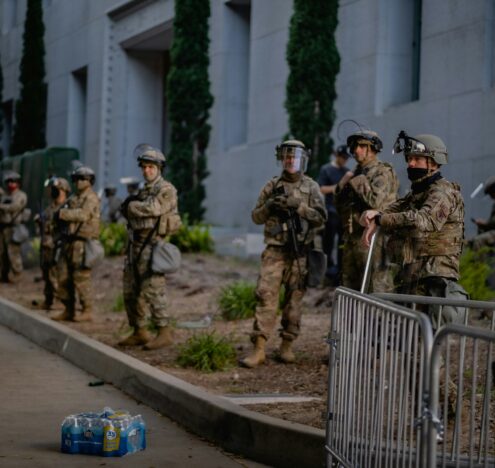From the Protestant church Sankt Peter und Paul in Görlitz, in the eastern German federal state of Saxony, one can easily see Poland. Next to the church, a pedestrian bridge stretches across the Lusatian Neisse, the river that marks the border between the neighboring countries. In May, the mayors of Görlitz and Zgorzelec — the town on the Polish side — laid wreaths commemorating the 80th anniversary of the end of the Second World War in Europe.
The bridge, which has no border controls, is an island of calm that contrasts with Germany’s agitated border politics. After an election campaign dominated by the topics of migration and asylum, Friedrich Merz, the leader of the center-right Christian Democratic Union (CDU), became chancellor of Germany on May 6. He presides over a coalition with the center-left Social Democratic Party of Germany (SPD).
The new Interior Minister, Alexander Dobrindt, soon announced that the German police would intensify their controls at the national borders. The controls, with regular checks of trains and buses crossing into Germany, were first implemented on all German borders by the previous government in September 2024, but are now ramping up.
Since May 7, an additional 3,000 police officers have been deployed at the borders, bringing the total up to 14,000. But the main change under the new government is that the police are also turning away asylum seekers at the borders, reportedly with exceptions for children and vulnerable people.
*
In May, I observed the intensified border controls at a bridge half a kilometer south of Görlitz’s city center. On the Zrgorzelec end of the bridge, police in Polish uniforms inspected the documents of two young men. On the opposite side of the bridge, barbed wire had been installed to prevent unauthorized entries, and the German police were stopping cars for checks. A young student told me that he had noticed that cars with multiple people and trucks are more likely to be stopped.
The border stops have caused increased traffic jams, especially during shift changes, since many Poles work in Germany.
During the first month of intensified border controls in Germany, 160 people who claimed asylum were turned back at the border, according to official statistics. The new German government argues that it is entitled to do this because Germany is land-locked and so surrounded by other EU countries — under the Dublin Agreement, the first country of arrival is usually responsible for processing asylum requests.
Legal experts argue that Germany, like any other EU country, can request that the first countries of arrival take back asylum seekers, but only after processing their cases and determining which country is responsible for them. On June 2, a Berlin court issued an emergency ruling that the state had illegally refused entry to three Somalis seeking asylum in Frankfurt an der Oder, at the German-Polish border. The court also ruled that the German government cannot justify its border policies under the pretext of an “emergency situation,” as it had sought to do. But the German government has continued with the pushbacks, arguing that the ruling only applies to the particular case of the Somali refugees.
*
Kiefersfelden is a German village with a population of approximately 7,000, situated in the foothills of the Kaiser Mountains in the Alps, near the border with Austria. In May, German interior minister Dobrindt, dressed in a police uniform, visited the town’s heavily manned border. The controls, he said, “are reducing illegal migration to Germany and taking consistent action against smugglers and traffickers.” Two weeks later, when I visited on a rainy afternoon, there was only a single police car parked next to the road.
“The measures currently implemented at Germany’s borders are doing little to reduce the number of asylum applications, at least not if you look at the statistics on apprehensions and refusals,” said Birgit Glorius, a professor of human geography at Chemnitz University of Technology. She notes that the current controls at the German borders “do not effectively reduce the asylum numbers.” Instead, “the measures, which have been heavily publicized in the media, are more likely to be understood as a deterrent strategy and as a measure to reassure the population by demonstrating the government’s ability for action.”
Germany’s border controls have a clear performative function. The CDU/CSU hopes that signaling a tougher migration policy will contain the far-right Alternative für Deutschland (AfD), which finished second in the last national elections for the first time in history, with 21% of the votes.
It is doubtful that the conservatives can recover votes from the AfD by further restricting the right to asylum. Among AfD voters, only 40% believe that the current border controls will result in a reduction in the number of asylum seekers reaching Germany, compared to 51% of the broader population. Meanwhile, only 9% of AfD voters are satisfied with the new government, 32% below the overall percentage.
Judith Kohlenberger, a Migration Researcher at the Vienna University of Economics and Business, notes that asylum seekers who are turned back typically arrive at border checks or official crossings. “Small paths and unpaved roads, typically not checked by police for lack of resources, have quickly become known to and used by smugglers. They are the actual beneficiaries of Germany’s new migration policy,” she explains.
*
There is no specific data available on the number of asylum seekers who have been rejected at each German border since May 7. Still, we know that between September 2024 and February 2025, the border where Germany turned back the most migrants was the one with Switzerland, followed by Austria, Poland, France, and the Czech Republic. Some of these neighbors have expressed their dissatisfaction with the new German policy. The Swiss Department of Justice defined the controls as a “violation of applicable law.” Meanwhile, the response from Austria has been more measured. Kohlenberger speaks about an “overall climate of cooperation” between the interior ministers of Germany and Austria.
Especially important for the new German government are relations with Poland and the Czech Republic, two key NATO partners at a time when the US under Donald Trump threatens to reduce its military presence in Europe. Merz has long emphasized his desire to improve Germany’s relations with Poland, which experienced a downturn under Chancellor Scholz. Poland is the NATO leader in defense spending as a percentage of GDP and fields the third-largest conventional NATO army. Merz seeks to work with both France and Poland in the framework of the Weimar Triangle, a forum for trilateral cooperation.
It was in Warsaw, during Merz’s second international visit as chancellor, that the new German leader saw how his migration policies might have negative effects on bilateral relations with Poland. In the press conference after meeting Merz, Polish Prime Minister Donald Tusk announced his country would not accept Germany sending back groups of migrants to Poland. Tusk also complained about the problems for commuters caused by the border controls and said the policy undermines the European spirit.
Bartosz Rydlinski, a professor of Political Science at Cardinal Stefan Wyszynski University in Warsaw, believes there is potential for further tensions between the German and the Polish governments. Rydlinski expects that the current leaders of both countries will likely attempt to increase deportations. “The more the extreme right grows in strength, the more the Christian Democratic parties will adopt its language and policies. They will do so in front of the cameras for public consumption to show that they are unyielding security defenders in their countries.”
The recent election of Karol Nawrocki as president of Poland on June 1 will only make relations between the two countries more complicated. Nawrocki is supported by the ultra-conservative, staunchly anti-immigration (and often anti-German) Law and Justice party. It remains to be seen what impact increasing tensions over migration policy will have on the relationship as a whole.
“The more the extreme right grows in strength, the more the Christian Democratic parties will adopt its language and policies. They will do so in front of the cameras for public consumption to show that they are unyielding security defenders in their countries.”
Bartosz Rydlinski
The likelihood of clashes between Germany and the Czech Republic over the former’s border policies appears to be lower. According to Robert Stojanov, a geographer at Mendel University in Brno who has researched Czech migration policies, the Czech Republic cannot afford a clash with the German government, “if only because of the interconnectedness of the two economies and the Czech economy’s dependence on exports to Germany and the need for German companies to rely on supply chains from the Czech Republic.” Stojanov predicts both governments will look for solutions, also because Berlin “will not want to lose a security partner at the European level in the current situation, where the Hungarian and Slovak Governments are causing significant problems.”
*
In 2024, while discussions on migration and asylum were prominent in German public debate, the number of asylum applications in Germany actually decreased by a third from the previous year. The decrease, Glorius points out, “is less likely to be due to stricter border controls at the German border than to a combination of containment measures implemented along the main migration routes to Europe and within Europe.” The tightening of entry regulations to Serbia, she notes, “led to a reduction in irregular migration on the Balkan route of around 75% in 2024.” The number of asylum-seekers, however, could rise again, as is often the case in warmer weather. This could strain the already complicated balance between Germany’s unilateral migration policy and its desire to maintain good relations with its neighbors.
Germany’s migration policy is already having unintended consequences. Some political commentators have argued that Nawrocki’s narrow victory (he received 51% of the vote) was helped by Germany’s border controls, which provided the right-wing populist candidate with an obvious target for anti-German agitation.
Kohlenberg notes that the far-right Freedom Party of Austria (FPÖ), currently in the opposition but leading the polls, “has always benefited from a strong (and increasing) anti-immigration sentiment of the Austrian population. They will try to capitalize on the current German policy, especially when arrival numbers start to rise again.” Meanwhile, in the Czech Republic, the right-wing populist party ANO of former Prime Minister Andrej Babiš is also in the opposition and polling first ahead of the October 2025 elections. ANO is attempting to scare voters with threats of Germany deporting a flood of migrants to the Czech Republic, explains Stojanov.
As it tries to undermine support for the domestic far-right by co-opting some of their anti-immigrant rhetoric, the German government could instead end up strengthening similar movements in neighboring countries — with unintended consequences for German security.




















